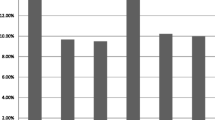Abstract
Despite advances in public health practice and medical technology, the disparities in health among the various racial/ethnic and socioeconomic groups remain a concern which has prompted the Department of Human and Health Services to designate the elimination of disparities in health as an overarching goal of Healthy People 2010. To assess the progress towards this goal, suitable measures are needed at the population level that can be tracked over time; Statistical inferential procedures have to be developed for these population level measures; and the data sources have to be identified to allow for such inferences to be conducted. Popular data sources for health disparities research are large surveys such the National Health and Interview Survey (NHIS) or the Behavior Risk Factor Surveillance System (BRFSS). The self-report disease status collected in these surveys may be inaccurate and the errors may be correlated with variables used in defining the groups. This article uses the National Health and Nutritional Examination Survey (NHANES) 99-00 to assess the extent of error in the self-report disease status; uses a Bayesian framework develop corrections for the self-report disease status in the National Health Interview Survey (NHIS) 99-00; and compares inferences about various measures of health disparities, with and without correcting for measurement error. The methodology is illustrated using the disease outcome hypertension, a common risk factor for cardiovascular disease.
Similar content being viewed by others
References
Carter-Pokras, O., Baquet, C. (2002): What is a ‘Health Disparity’? Public Health Reports 117, 426–434
Duncan, O.D., Duncan, B. (1955): A methodological analysis of segregation indices. American Sociological Review 20, 210–217
Firebaugh, G. (1999): Empirics of world income inequality. American Journal of Sociology 104, 1597–1630
Gakidou, E.E., Murray, C.J., Frenk, J. (2000): Defining and measuring health inequality: an approach based on the distribution of health expectancy. Bulletin of the World Health Organization 78, 42–54
Gelman, A.E., Carlin, J.P., Stern, H., Rubin, D.B. (1993): Bayesian Data Analysis. Chapman Hall, Boca Raton, Florida
Kakawani, N., Wagstaff, A., Vandoorslaer, E. (1997): Socioeconomic inequalities in health, measurement, computation, and statistical inference. Journal of Econometrics 77, 87–103
Krieger, N., Fee, E. (1996): Measuring social inequalities in health in the United States: a historical review, 1900–1950. International Journal of Health Services 26, 391–418
Mackenbach, J.P., Kunst, A.E. (1977): Measuring the magnitude of socio-economic inequalities in health: an overview of available measures illustrated with two examples from Europe. Social Science and Medicine 44, 757–771
Mackenbach, J.P., Cavelaars, A.E.J.M., Kunst, A.E. (1997): Socioeconomic inequalities in morbidity and mortality in Western Europe – Reply. Lancet 350, 517–518
National Center for Health Statistics (2000–2002): National Health Interview Survey, Hyattsville, Maryland, USA
Pearcy, J.N., Keppel, K.G. (2002): A summary measure of health disparity. Public Health Reports 117, 273–280
Poole, C. (2000): Origins of risk relativism. American Journal of Epidemiology 151, 46
Preston, S.H., Haines, M.R., Pamuk, E. (1981): Effects of industrialization and urbanization on mortality in developed countries. In: International Population Conference, Solicited Papers, Manila, vol. 2, pp. 233–254. Ordina Editions, Leige
Author information
Authors and Affiliations
Corresponding author
Additional information
JEL classification
C1 (C11, C13, C15), C4 (C42) and I3 (I31, I38)
Rights and permissions
About this article
Cite this article
Raghunathan, T.E. Combining information from multiple surveys for assessing health disparities . Allgemeines Statistisches Arch 90, 515–526 (2006). https://doi.org/10.1007/s10182-006-0003-0
Published:
Issue Date:
DOI: https://doi.org/10.1007/s10182-006-0003-0




